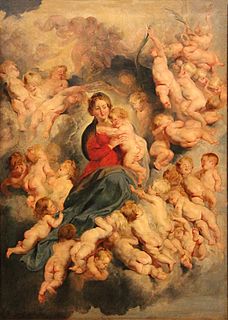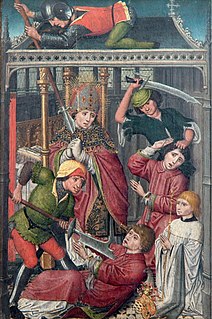This article needs additional citations for verification .(January 2020) |
Tyfei (early 6th century) was a martyr and saint of the medieval Welsh church.
This article needs additional citations for verification .(January 2020) |
Tyfei (early 6th century) was a martyr and saint of the medieval Welsh church.
Tyfei ap Budic was the second son of Budic II of Brittany and his second wife, Anowed or Arianwedd, the daughter of Saint Issel and sister of Saint Teilo. The young Tyfei attempted to intervene in a heated argument between a swineherd and the owner of a field the animals had trespassed. In the course of the confrontation, Tyfei sustained an accidental, 'though lethal wound from a javelin. [1]
Tyfei was buried at Penalun (Penally) in Dyfed. [2]
Although his death was apparently accidental, veneration of Tyfei was likely due to his family connections, and he is sometimes called a martyr. At the time, Budic was in exile, a cousin having usurped his throne in Cornouaille. Patricia Healy Wasyliw suggests "...that the legend may mask a political assassination". [3]
Churches were dedicated to St. Tyfei at Llandyfeisant, [4] and Lamphey. [5]

The Massacre of the Innocents is the incident in the nativity narrative of the Gospel of Matthew (2:16–18) in which Herod the Great, king of Judea, orders the execution of all male children two years old and under in the vicinity of Bethlehem. The Catholic Church regards them as the first Christian martyrs, and their feast – Holy Innocents' Day – is celebrated on 28 December. A majority of Herod biographers, and "probably a majority of biblical scholars," hold the event to be myth, legend, or folklore.

In religion, a relic is an object or article of religious significance from the past. It usually consists of the physical remains of a saint or the personal effects of the saint or venerated person preserved for purposes of veneration as a tangible memorial. Relics are an important aspect of some forms of Buddhism, Christianity, Islam, shamanism, and many other religions. Relic derives from the Latin reliquiae, meaning "remains", and a form of the Latin verb relinquere, to "leave behind, or abandon". A reliquary is a shrine that houses one or more religious relics.

Deheubarth was a regional name for the realms of south Wales, particularly as opposed to Gwynedd. It is now used as a shorthand for the various realms united under the House of Dinefwr, but that Deheubarth itself was not considered a proper kingdom on the model of Gwynedd, Powys, or Dyfed is shown by its rendering in Latin as dextralis pars or as Britonnes dexterales and not as a named land. In the oldest British writers, Deheubarth was used for all of modern Wales to distinguish it from Hen Ogledd, the northern lands whence Cunedda and the Cymry originated.
Ecgberht I was a King of Kent (664-673), succeeding his father Eorcenberht.

Saint Winifred was a Welsh virgin martyr of the 7th century. Her story was celebrated as early as the 8th century, but became popular in England in the 12th, when her hagiography was first written down.
Wigstan, also known as Saint Wystan, was the son of Wigmund of Mercia and Ælfflæd, daughter of King Ceolwulf I of Mercia.

Lambert of Maastricht, commonly referred to as Saint Lambert was the bishop of Maastricht-Liège (Tongeren) from about 670 until his death. Lambert denounced Pepin's liaison with his mistress Alpaida, the mother of Charles Martel. The bishop was murdered during the political turmoil that developed when various families fought for influence as the Merovingian dynasty gave way to the Carolingians. He is considered a martyr for his defence of marriage. His feast day is September 17.
Constantine was a 6th-century king of Dumnonia in sub-Roman Britain, who was remembered in later British tradition as a legendary King of Britain. The only contemporary information about him comes from Gildas, who castigated him for various sins, including the murder of two "royal youths" inside a church. The historical Constantine is also known from the genealogies of the Dumnonian kings, and possibly inspired the tradition of Saint Constantine, a king-turned-monk venerated in Southwest Britain and elsewhere.

Rumwold was a medieval infant saint in England, said to have lived for three days in 662. He is said to have been full of Christian piety despite his young age, and able to speak from the moment of his birth, professing his faith, requesting baptism, and delivering a sermon prior to his early death. Several churches were dedicated to him, of which at least four survive.

Saint Kenelm was an Anglo-Saxon saint, venerated throughout medieval England, and mentioned in the Canterbury Tales. William of Malmesbury, writing in the 12th century, recounted that "there was no place in England to which more pilgrims travelled than to Winchcombe on Kenelm's feast day".

Lamphey is both a village, a parish and a community near the south coast of Pembrokeshire, Wales, approximately 2 miles (3.2 km) east of the historic town of Pembroke, and 2 miles (3.2 km) north of the seaside village of Freshwater East. The 2011 census reported a population of 843.

Saint Oudoceus (Latin) or Euddogwy (Welsh) is generally known as the third Bishop of Llandaff in South Wales. In reality he was probably a 7th-century bishop at Llandeilo Fawr. Wendy Davies puts his episcopal reign between about 650 and 700.
Saint Tanca is the name of a sixth-century French Roman Catholic saint.

Pierre de Luxembourg was a French Catholic prelate who served as the Bishop of Metz, and as a cardinal of the Avignon Obedience from 1384 until his death.
Edward Vaughan was a Welsh bishop of St David's, remembered for construction work in his diocese.

Domne Eafe, also Domneva, Domne Éue, Æbbe, Ebba, was, according to the Kentish royal legend, a granddaughter of King Eadbald of Kent and the foundress of the double monastery at Minster-in-Thanet during the reign of her cousin King Ecgberht of Kent. A 1000-year-old confusion with her sister Eormenburg means she is often now known by that name. Married to Merewalh of Mercia, she had at least four children. When her two brothers, Æthelred and Æthelberht, were murdered she obtained the land in Thanet to build an abbey, from a repentant King Ecgberht. Her three daughters all went on to become abbesses and saints, the most famous of which, Mildrith, ended up with a shrine in St Augustine's Abbey, Canterbury.
Budic II, formerly known as Budick, was a king of Cornouaille in Brittany in the late 5th and early 6th centuries. He was father of Hoel as well as several Celtic saints.
Isfael or Ismael, often anglicized as Ishmael, was a 6th-century medieval Welsh bishop of Rhos and saint. He was allegedly also a Breton prince of Armorica.

Sicarius of Brantôme or Sicarius of Bethlehem was a child saint who was venerated from the time of Charlemagne onwards as one of the victims of the Massacre of the Innocents by Herod the Great, said to have occurred in Bethlehem at the time of the birth of Jesus. His remains are housed in the Abbey of Saint-Pierre in Brantôme, Dordogne, France.

St Tyfi's Church is the former parish church of Llandyfeisant, near Llandeilo and part of the Dinefwr Park estate in Carmarthenshire, Wales. It was dedicated to the Welsh saint Tyfei, nephew of Saint Teilo.